Related Research Articles

Charles Lapworth FRS FGS was a headteacher and an English geologist who pioneered faunal analysis using index fossils and identified the Ordovician period.
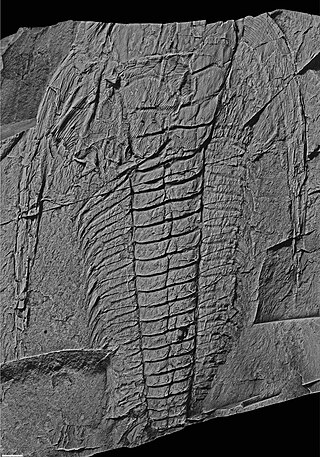
John William Salter was an English naturalist, geologist, and palaeontologist.

James Nicol FRSE FGS was a Scottish geologist.
The geology of Shropshire is very diverse with a large number of periods being represented at outcrop. The bedrock consists principally of sedimentary rocks of Palaeozoic and Mesozoic age, surrounding restricted areas of Precambrian metasedimentary and metavolcanic rocks. The county hosts in its Quaternary deposits and landforms, a significant record of recent glaciation. The exploitation of the Coal Measures and other Carboniferous age strata in the Ironbridge area made it one of the birthplaces of the Industrial Revolution. There is also a large amount of mineral wealth in the county, including lead and baryte. Quarrying is still active, with limestone for cement manufacture and concrete aggregate, sandstone, greywacke and dolerite for road aggregate, and sand and gravel for aggregate and drainage filters. Groundwater is an equally important economic resource.
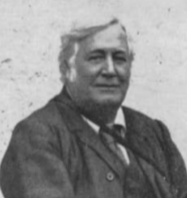
Benjamin Neeve Peach was a British geologist.
Latouchella is an extinct genus of marine invertebrate animal, that is considered to be a mollusk and which may be a sea snail, a gastropod. It is a helcionellid from the Tommotian epoch of what is now Siberia. Its tightly coiled, spiral shell contains a number of low "walls" running up the front surface of the interior; these would have directed water currents within its shell. Between these walls are a series of furrows, parallel to the shell's aperture, giving casts of the internal structure the appearance of a railway line, with sleepers tying together paired rails that run towards the apex of the shell.
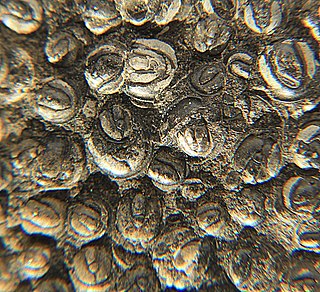
Agnostus is a genus of agnostid trilobites, belonging to the family Agnostidae, that lived during the late Middle Cambrian – early Upper Cambrian. It is the type genus of the family Agnostidae and is subdivided into two subgenera, Agnostus and Homagnostus.
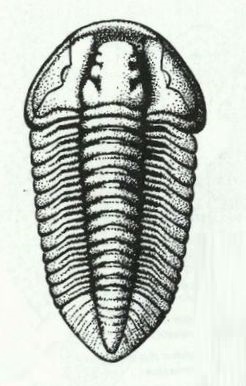
Flexicalymene Shirley, 1936. is a genus of trilobites belonging to the order Phacopida, suborder Calymenina and Family Calymenidae. Flexicalymene specimens can be mistaken for Calymene, Gravicalymene, Diacalymene and a few other Calymenina genera. They are used as an index fossil in the Ordovician. Ohio and North America are particularly known for being rich with Flexicalymene fossils.
Stephen Robert Nockolds, FRS was a geochemist, petrologist and winner of the Murchison Medal of the Geological Society of London.
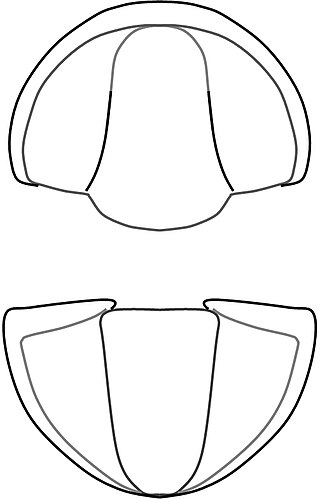
Cobboldites Kobayashi, 1943, is a genus of Eodiscinid trilobite belonging to the family Weymouthiidae Kobayashi T. (1943), Order Agnostida It lived during the Botomian stage, which lasted from approximately 524 to 518.5 million years ago. This faunal stage was part of the Cambrian Period.
Leptochilodiscus Rasetti, 1966 [= Kerberodiscus Bassett et al., 1976] is a genus of Lower Cambrian Eodiscinid trilobite belonging to the family Weymouthiidae Kobayashi (1943), Order Agnostida. It lived during the Botomian stage = late Lower Cambrian Stage 4 ; the upper Botomian Stage boundary corresponds to base of both the Middle Cambrian Wuliuan stage and Miaolingian Series.
Runcinodiscus Rushton is a genus of Lower Cambrian Eodiscinid trilobite belonging to the family Weymouthiidae, Order Agnostida.

The Comley Limestone is an Early Cambrian Lagerstätte exposed in Comley, Shropshire, England. It is known for its phosphatic microfossils, which can be extracted by acid maceration and are preserved in three dimensions in a similar fashion to the Orsten fossils. It represents around 10 million years of deposition, and was deposited from 519 to 501 million years ago. Fossils from the formation include the phosphatocopine arthropod Klausmuelleria.

Weymouthia is an extinct genus of eodiscinid agnostid trilobites, which lived at the end of the Lower Cambrian, in what are now the eastern United States, England, Siberia and China.

Pleuroctenium Hawle & Corda (1847) is an agnostid trilobite belonging to the family Condylopygidae Raymond (1913). The genus occurs in Middle Cambrian (Drumian) strata of Canada, the Czech Republic, England and Wales, France, and Sweden.
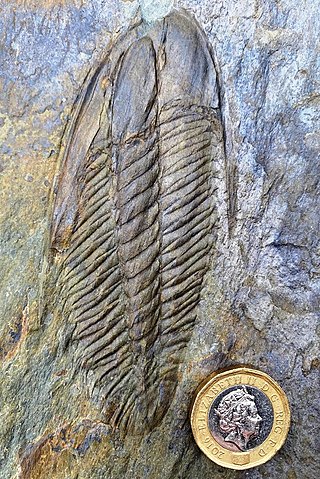
Angelina Salter, 1859, is a genus of ptychopariid trilobite belonging to the Family Olenidae, Suborder olenina. It lived during the Tremadocian Stage, lowermost of the two standard worldwide divisions forming the Lower Ordovician Series and lowest of the seven stages within the Ordovician System. It encompasses all rocks formed during Tremadocian times, which spanned the interval between 485.4 million and 477.7 million years ago. Fossilized remains of Angelina are known from Wales, Central and South America. It differs from most other Triarthrinae in being larger, with a relatively narrow glabella, the occipital ring poorly defined, and lateral glabellar furrows relatively obscure. Eyes are placed midlength that of the cephalon and the facial sutures converge on the front border at the midline. Species also have long genal spines.
The Hells Mouth Grits, formally defined and renamed the Hells Mouth Formation by Young et al., is a geological formation composed of Cambrian Greywackes in the south west part of St. Tudwal's Peninsula. Equivalent to the Rhinog Formation in the Harlech Dome, the grit beds exposed at St Tudwal's are very uniform in lithology and thickness when traced along the outcrops, with a gradual thinning southwards. They exhibit the characteristic textures and structures of greywackes but differ from the normal type in being relatively well sorted and commonly laminated. Intercalated mudstones are more variable both in thickness and in lithology and contain laminated mudstones rich in sponge remains. The sandstones have sharply defined bases, often bearing sole structures and occasionally loaded. Sandstone dykes cut down from the bases of some beds and extend through up to 0.6 m of underlying siltstones. The sandstones may form sheets up to 4 m thick, although a bed thickness of up to 1m is more usual, and have been interpreted as turbidites deposited by currents from the northeast.

Plutonides is a genus of Middle Cambrian trilobite in the family Paradoxididae with species Plutonides sedgwickii and possibly Plutonides? illingi. Several other species and subspecies were at times placed in Plutonides but have subsequently been moved to other genera.

Serrodiscus Richter and Richter 1941. is a genus of Eodiscinid trilobite belonging to the family Weymouthiidae Kobayashi T. (1943), Order Agnostida. It lived during the late Lower Cambrian, with remains found in Canada, China (Gansu), The United Kingdom (England), Germany (Silesia), Poland, the Russian Federation, and the United States. It is named for the spines on the ventral side of the pygidium, which give it a serrated impression.

Bailiaspis Resser, 1936, is a Middle Cambrian (Miaolingian) trilobite genus belonging to the Family Conocoryphidae Angelin, 1854. Within the Acado-Baltic region, the genus ranges from Wuliuan into Guzhangian age strata.
References
- 1 2 W., W. W. (January 14, 1937). "Dr. E. S. Cobbold". Nature. 139 (3507): 101–102. Bibcode:1937Natur.139..101W. doi:10.1038/139101b0 – via www.nature.com.
- ↑ Neal, Toby (July 20, 2020). "Flashback to 2001: Scientists hit the jackpot with Shropshire fossil". www.shropshirestar.com.
- ↑ "Page 3408 | Issue 26747, 9 June 1896 | London Gazette | The Gazette". www.thegazette.co.uk.
- ↑ "Library Notes and News" (PDF). Bulletin of the John Rylands Library, Manchester. 14 (2): 303. July 1930. Retrieved 14 Jan 2024.
- ↑ Cobbold, Edgar Sterling (January 15, 1910). "On some small Trilobites from the Cambrian Rocks of Comley (Shropshire)" – via Internet Archive.
- ↑ "VIII. The Cambrian area of Rushton (Shropshire)". Philosophical Transactions of the Royal Society of London. Series B, Containing Papers of a Biological Character. 223 (494–508): 305–409. January 14, 1934. doi: 10.1098/rstb.1934.0008 .